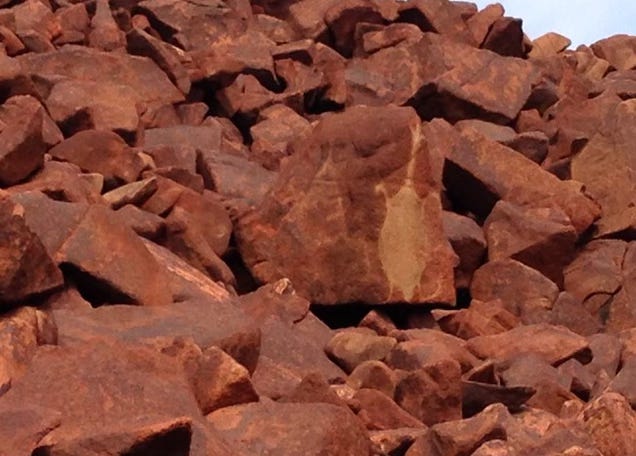Having been twice to the Burrup Peninsula in north-western Australia, I don’t need convincing about the importance of the rock art site, Murujuga. If an archaeologist as experienced as Ken Mulvaney holds concerns about the potentially damaging impact of emissions from the expansion of Woodside’s gas plant there’s good reason to be alarmed.
Much of the rock art at Murujuga dates back tens of thousands of years, even including an image of a thylacine – the extinct “Tasmanian tiger” that once roamed the Pilbara but was gradually forced down to the lowest point of the continent when the island was still joined to the mainland. The songlines that began in the Burrup would stretch right across Australia.
It's already disturbing to see massive gas plants in such close proximity to the site, and further expansion will only make the encroachment more oppressive. I’m no expert on the archaeology or the climate science, but given the usual attitude of our mining companies can one credit Woodside’s protestations of respect for the heritage of the site? Rio Tinto’s cavalier destruction of rock shelters in Juukan Gorge in 2020 did nothing to foster trust in the resources sector.
Feeling sceptical of the Burrup Peninsula development doesn’t, however, translate into support for a protest by climate activist, Joana Partyka, who spray painted a Woodside logo on the glass in front of Frederick McCubbin’s iconic Down on his Luck, at the Art Gallery of Western Australia last January. These art gallery protests, whereby activists spray paint or throw food onto some well known painting, are cowardly, counterproductive acts. They draw on the fame of a work to generate publicity, taking comfort from the relaxed security of an art museum. The protestors also seem to believe they won’t be treated harshly by the courts, as it’s only the frame and glass that sustains damage.
This complacent idea has been overturned recently in London by the sentences handed to two youthful activists who threw cans of soup at Van Gogh’s Sunflowers in the National Gallery. The pair, both in their early twenties, received 27 and 20 months respectively, notwithstanding a heroic speech in the dock. All over Europe, the authorities are toughening up on this form of protest, increasing fines and threatening gaol time.
In Perth, Partyka escaped with a $2,000 fine and a $5,000 damage bill. She had the compensation of seeing her handiwork acquired by the Western Australian Museum, which views the spray-painted perspex as a significant piece of social history. As the outrage escalated, CEO Alec Coles was quick to reassure critics that the museum condemns “the targeting of cultural institutions for such protests which risk damage to public collections and inconveniencing visitors.”
So why was the piece collected? Being no more than a bit of old perspex with a yellow logo stencilled on it, there’s not a lot of creativity involved, unlike some of the elaborate protest banners of the past. It’s hardly possible to escape the idea that the acquisition serves as an implicit endorsement of the protest. As the incident took place in a neighbouring museum it’s also a conspicuously non-collegial gesture. There may have been no cost to the taxpayer, but there is no conspicuous benefit either.
Partyka herself has referred to the acquisition as “validating”, which should make the WA Museum rethink its disclaimers. In her own words:
“The fact that the museum, one of the premier cultural institutions in Western Australia and the custodian of our history, the fact that they see the historical significance of the perspex and in turn the significance of the Disrupt Burrup Hub campaign … as part of the story of Western Australia, it’s very validating.”
It's easy for a museum director to say it’s merely a matter of documenting “the issues and events that affect our society.” This incident has already been widely documented. By acquiring the defaced sheet of perspex the institution can’t help but add its cultural authority to the protest. In an era when so many museums are going out of their way to adopt strident political positions, the WA Museum has made an overtly political gesture while insisting on its neutrality! The protester’s view is more credible than the museum’s. The acquisition is – and can only be - a validation.
There are plenty of ways to protest that don’t involve gratuitous damage to works of art in museums. When the courts are scaling up the disincentives for actions they see as vandalistic publicity stunts, it strikes a discordant note when another cultural institution sees social history in the making.
I’ve had a very busy week, working on a lecture called What is a Museum (Today)?, along with two long drives. As a result, something had to give and it’s the movie column. I’m posting a piece on the Magritte exhibition that has just opened at the Art Gallery of NSW, which includes a fair sampling of the artist’s greatest hits. As an extra, I’m adding a piece on Jeffery Smart’s Cable Coils, written for the catalogue of a forthcoming Menzies auction.
There’s been plenty of feedback for last week’s newsletter on Abdul-Rahman Abdullah’s politically-charged social media posts, that cost him his membership of the National Gallery Council. The question many are asking is: “Why hasn’t NGA Director, Nick Mitzevich or Arts Minister, Tony Burke, felt obliged to make a statement?” The answer is obvious: They’re hoping this incident will vanish into the thin air and never be mentioned again. Judging by some of the anger and distress out there, this may be a trifle optimistic.




